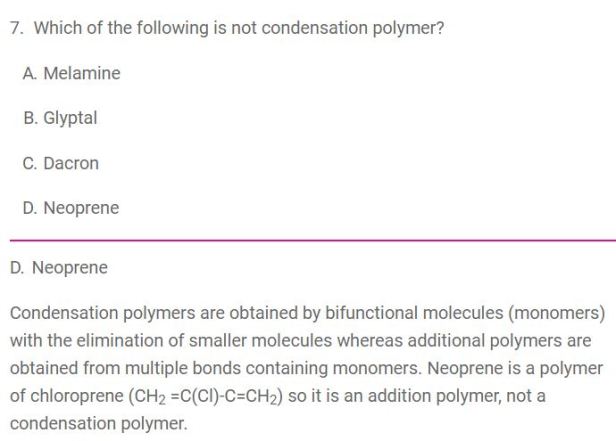Chapter Summary of Polymer Class XII Questions and Answers
One of the fields of science is Chemistry and yes, it starts right from when we study about it in school. One of the aspects in Chemistry that our lives are so intertwined with is that of Polymers.
Polymers are made up of many molecules, all strung together to form really long chains. The term Poly- means “many” and Mer refers to “part” or “segment”. Mono means “one”. So, monomers are those itsy bitsy molecules that can join together to make a long polymer chain. This process of formation of polymers from respective monomers is called polymerization.
Many- Many Monomers Make a Polymer
So exactly how many is “many- many -many “? Well, usually a single polymer molecule is made out of hundreds of thousands (or even million!) of monomers! So you can extrapolate from there.
There are several ways of classification of polymers. The following are some of the common classification of polymers:
Classification based on source:
Natural polymers: These polymers are found in plants and animals. For example, proteins, cellulose, starch, some resin and rubber are all polymers.
Synthetic polymers: A variety of synthetic polymers as plastic (polythene), synthetic fibers (nylon6, 6) and synthetic rubber (Buna-S) are examples of man-made polymer.
There is a whole bunch of different ways that can describe polymers and what they look like. Just to get a feel for where polymers are around us, just visit a store. Look around the goods kept on display and you will see all the stuff that’s made out of polymers. Polymeric materials such as shellac, amber, wool, silk and natural rubber have been used for centuries. Polybag, plastic bottles, and footwear are the common examples of polymers that we use in daily life.
This chapter has 3 marks weightage in board exam. The important topics for the preparation of NEET and JEE are given as:-
Classification Based on Source
Classification Based on Structure of Polymers
Classification Based on Mode of Polymerisation
Classification Based on Molecular Force
Classification Based on Growth Polymerisation
Addition Polymerisation or Chain Growth Polymerisation
Condensation Polymerisation or Step Growth polymerisation
Copolymerisation
Rubber
To learn about each topic in detail student can read ncert chemistry class 12 part 2 textbook chapter Polymer. Students who are preparing for NEET and JEE exam can also access NEET chemistry Questions bank 2018 prepared by the expert teachers. You can also get solutions of last year 2017 NEET Chemistry papers.
We have provided sample questions for your reference. To learn more click here.


